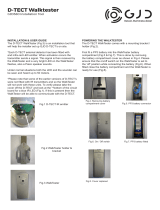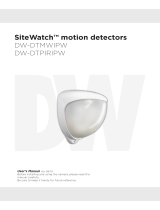Page is loading ...

PACKAGE CONTENTS
• 1 x D-TECT 50 AM
• 1 x Drilling template for xing holes
• 3 x 31.75mm wall plugs
• 3 x 31.75mm screws
• 1 x Tamper cup
• 2 x Tamper feet
• 1 x Installation manual
• 1 x 5m wide Fresnel lens (Lens 2, Fig.12)
INTRODUCTION
The D-TECT 50 AM is an outdoor motion detector and
alarm trigger that uses two independent passive infra-red
detectors, both of which must trigger to cause the detector
to signal an alarm. Utilising quad PIR technology, the
D-TECT 50 AM delivers precise, reliable presence
detection and will alarm if tampered by masking.
The integral dual axis tilt sensor allows 180° of pan and
45° tilt. This increases the speed of the outdoor installation
and provides incredibly accurate aiming of the detection
pattern. The electronics module is acrylic coated for
additional component stability. It is encased in a vandal-
resistant high impact zinc alloy housing with a UV stabilised
translucent front cover ensuring the sensor is impervious
to and unaffected by weather conditions. Additionally the
combination of precision electronics, digital white light lter
and double shielding eliminates false alarms from the sun
and other visible light sources.
The D-TECT 50 AM design gives a neat and professional
appearance with no visible indication of the orientation of
the detector head, and totally hides the wiring.
QUICK INSTALLATION GUIDE
Apply supply voltage to the unit, the amber led ashes 10
times, then the blue LED ashes 3 times.
The detector takes approximately 2-3 minutes to settle. The
walk test led is factory set to OFF. Pressing the program
button once will enable the walk test LED for 5 minutes.
THE FRONT COVER MUST BE FITTED WHEN WALK
TESTING
FACTORY SETTINGS ARE:
1 RANGE 50 METRES
2 PULSE COUNT 1
3 LED OFF
When enabled the D-TECT 50 AM has two LED indicators.
Blue - Alarm output, both PIRs and microwave detection
Amber - Anti-Mask detection
ANTI-MASKING CIRCUIT
The cover must be tted before applying power to the
detector.
During the rst 10 seconds after power has been
connected, the amber LED ashes and the anti-masking
circuit starts to self calibrate. The amber LED indicates
when the detector is covered, but the relay contacts do not
operate until the unit has been covered for 60 seconds.
SEQUENCE FOR CORRECT OPERATION
1. Make connections and replace cover.
2. Apply 12 volts power. Amber LED Flashes 10 times -
self calibration completed.
3. Cover detector for 60 seconds. When anti-mask
detection is continuous for 60 seconds the normally
closed relay will open until anti-mask detection is
cleared.
MOUNTING THE UNIT
During installation the electronics must be protected
against water, as trapped moisture can affect or damage
the unit.
1. Using the template provided drill the wall to accept
the two xing screws, the cable entry and the tamper
cup (if used). See g 1 and 2.
Note: We recommend using the tamper cup on uneven wall
surfaces.
2. Remove the cover assembly by loosening the locking
screw. The cover hinges from the top and lifts out of
the location slot. See g 3.
3. Feed standard 8 core alarm cable into the cable
entry; bare the wires and connect to the terminal
block as shown in g 7. Screw the unit to the wall
ensuring that the tamper pin is correctly located
and that the tamper microswitch is closed. See g
4 and 5. To aid installation, two spare tamper feet
are provided. One is 1mm longer and the other is
2mm longer than the tamper foot originally tted.
The tamper foot is a push t and can be removed by
carefully pulling it from the pin. See g 2.
4. When the detector has been aligned to suit the
installation, replace the front cover and lock as
shown. See g 6.
1
D-TECT 50 AM
GJD359 Anti-Masking 50m Quad PIR Detector
Detect.Illuminate.Dete
r

CONNECTING THE UNIT
BEAM ALIGNMENT
PIR circuitry detects changes in heat and movement in the
beam pattern. Objects such as trees, shrubs, ponds, ues,
and animals should be considered when positioning the
detector.
Note: The PIR sensor is more sensitive to movement
across the beams, and less sensitive to movement
directly towards or away from the beams.
When coverage exceeds the desired detection area, adjust
the module as required to avoid unwanted detection.
Optimum mounting height for the detector with Lens1 (Fig.
11) is 3m. Heights above 3m could result in a signicant
reduction in the range of detection and the target will have
to move a greater distance within the eld of view to alarm.
Mounting height for the narrow width Lens2 is maximum
2.6m.
Figures 7/8 show side and top down views of the 10m wide
(Lens1) pattern. Figures 9/10 show the 5m
wide (Lens2) pattern.
PROGRAMMING
The user can individually program a number of congurable
settings as illustrated in the programming chart. Factory
settings are shown as shaded boxes. Changes to the
existing settings can easily be made.
To reset the factory settings simply remove power from the
detector, press and hold the program button (see g 14)
whilst temporarily applying power to the detector: either
before installation, with a PP3 battery, or by applying 12
volts to the unit on site. The Amber LED will ash 10 times,
the blue LED will ash 3 times then the blue LED will ash
rapidly then release the program button.
A/M ALARM/NC TAMPER ALARM/NO + -
9-15 VDC
PROGRAMMING CHART
OPTIONS
SETTING
1 2 3
1Range (m) 25 40 50
2Pulse Count 1 2
3LED OFF ON
EXAMPLE
To change the LED setting from OFF to ON.
1. Press the program button three times and release
the button.
2. Wait until the indicator goes off.
3. The indicator will now ash once.
4. Press the program button twice and release the
button.
5. The indicator ashes twice showing that the option
has been stored and the detector returns to normal
operation.
WALK TEST
The range of the detector increase without the front
protective cover. Therefore the front cover must be tted
to establish the correct beam pattern alignment and when
testing the outputs. Use the programming chart to adjust
the range as necessary and pan and tilt the lens module
over the eld of view to obtain the correct coverage area.
When the ‘program’ button is pressed momentarily the
blue indicator lights and pulse count ‘1’ is automatically
selected. The unit can then be aligned. The blue indicator
will light on the D-TECT 50 AM every time a detection takes
place. This test mode will automatically cancel ve minutes
after last detection. Alternatively, remove the power and
then re-apply.
Note: When you conduct a walk test, make sure that the
front cover is in place. Do not conduct walk tests with the
cover removed.
OPTION DEFINITIONS
PULSE COUNT
This is the number of times the unit has to detect on both of
its sensors before signalling an output.
LED MONITOR
LED Off - LED disabled.
LED on - LEDs signal a detection.
ACCESSORIES
GJD is able to supply the following accessories to aid
installations:
PMB1 Pole mount bracket
GJD380 D-TECT walk tester
2

Detection Area Programmable between 25m & 50m
Coverage 13 degrees detection angle, 50m x
10m coverage max.
Two Fresnel lenses giving up to 50m x
5m or 50m x 10m (Standard)
Adjustment 180° pan + 90° tiltt
Customised Optics Double silicon shielded quad element
eliminates 50,000 Lux of white light
Outputs Silent solid state magnetically immune
Alarm N/O N/OPEN Volt free relay signal
contact 24VAC/DC
@ 50mA with an
integral 25R series
resistor
Alarm time 5
seconds
Alarm N/C N/CLOSED Volt free relay signal
contact 24VAC/DC
@ 50mA with an
integral 25R series
resistor
Alarm time 5
seconds
AM N/CLOSED Volt free relay signal
contact 24VAC/DC
@ 50mA with an
integral 25R series
resistor
Alarm time 5
seconds
Tamper N/CLOSED Cover and rear
tamper switches
Power Input 9 to 15 VDC
Current 15mA (12V nominal)
Pulse Count 1 - 2
Temp Compensation Digital sensitivity adjustment
Control Digital microprocessor - non volatile
memory
Walk Test Output test mode with LED indication
Operating Temp -20ºC to +55º C
Conformally coated electronics for
increased stability
Housing High impact zinc alloy
Protection Rating IP65
Dimensions 145 x 120 x 115 mm
Weight 750grams NET, 880 grams GROSS
Mounting Height Variable - maximum height 3 metres
Cable <200m Utilising all three outputs (incl. tamper)
- 8 core 7/0.2mm
Cable <500m Utilising all three outputs (incl. tamper)
- 8 core 16/0.2mm
Certications
3

4
1
2 3
4
6
5
7
Optional for Tamper Cup
Cable Holes
Template
3m
50m

5
8
10
9
11
2.6m
50m
Max.
5m
12 13
14
A/M ALARM/NC TAMPER ALARM/NO + -
9-15 VDC
A/M ALARM/NC TAMPER ALARM/NO + -
9-15 VDC
PROGRAM
Program Button
Blue LED

Unit 2, Birch Business Park, Whittle Lane, Heywood, Greater Manchester, OL10 2SX, UK
w: www.gjd.co.uk t: +44 (0) 1706 363 998 f: +44 (0) 1706 363 991
ENGINEER NOTES
/










